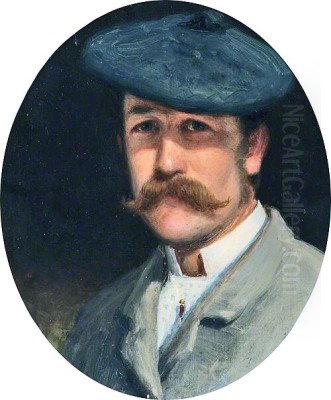
Joseph Farquharson stands as a significant figure in late 19th and early 20th-century Scottish art. Renowned primarily for his evocative and atmospheric depictions of snow-laden landscapes, often populated by sheep, he carved a unique niche for himself. His ability to capture the subtle nuances of light, particularly during the liminal hours of dawn and dusk, combined with a meticulous realism, earned him considerable acclaim during his lifetime and ensures his enduring appeal. Balancing his artistic career with the responsibilities of a landed gentleman, he became affectionately known by nicknames such as "Frozen Mutton Farquharson" and "The Painting Laird," reflecting both his favoured subject matter and his social standing.
Early Life and Artistic Awakening
Born in Edinburgh, Scotland, on May 4, 1846, Joseph Farquharson was immersed in an environment conducive to artistic pursuits from a young age. His father was a respected physician who also practiced art as an amateur, providing early encouragement. His mother hailed from the Farquharson family, Lairds of Finzean, connecting him to the Aberdeenshire estate that would later become central to his artistic identity. This blend of professional Edinburgh society and rural aristocratic heritage shaped his perspective.
His formal artistic education began in Edinburgh at the prestigious Trustees' Academy, an institution instrumental in training many notable Scottish artists. Here, he would have received a solid grounding in drawing and traditional techniques. An influential early mentor during this period was Peter Graham (1836-1921), another prominent Scottish landscape painter known for his dramatic Highland scenes. Graham's guidance undoubtedly played a role in steering Farquharson towards landscape painting and honing his observational skills.
Parisian Studies and French Influences
Seeking to broaden his artistic horizons, Farquharson travelled to Paris during the 1880s, a crucial step for many ambitious artists of his generation. He enrolled in the atelier of Émile Carolus-Durand (1837-1917), a highly successful portraitist and history painter who was also known for his fashionable and technically brilliant style. Carolus-Durand, himself influenced by the realism of Diego Velázquez, ran a popular studio that attracted international students, including the American painter John Singer Sargent.
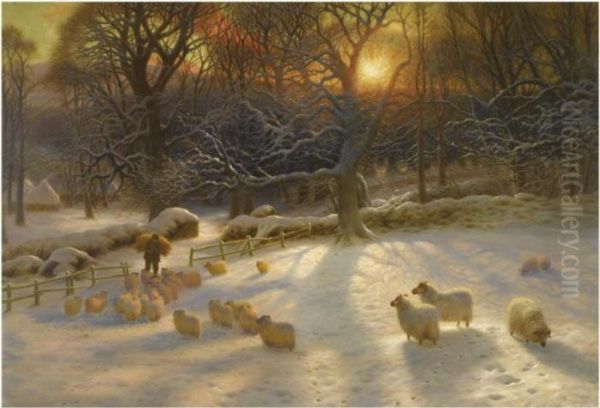
Exposure to the vibrant Parisian art scene was transformative. Farquharson absorbed the prevailing trends of French Realism and Naturalism. While not strictly an Impressionist, he was certainly aware of the movement and its emphasis on light and capturing fleeting moments. The work of artists like Gustave Courbet (1819-1877), a leading figure of Realism known for his unidealized depictions of rural life and landscapes, resonated with Farquharson's own interest in portraying the natural world truthfully. Comparisons were drawn between Farquharson's robust realism and Courbet's approach, highlighting Farquharson's standing. He likely also saw works by Barbizon School painters such as Jean-François Millet (1814-1875) and Camille Corot (1796-1875), who championed direct observation of nature.
The Signature Style: Snow, Sheep, and Light
Upon returning to Scotland, Farquharson synthesized his Scottish roots and French training to develop his characteristic style. He became most famous for his winter landscapes, particularly those featuring sheep navigating snowy terrain under the soft, raking light of sunrise or sunset. These works masterfully convey the cold, crisp atmosphere of the Scottish winter, the texture of snow – powdery, crisp, or thawing – and the resilient presence of the animals.
His handling of light was exceptional. He captured the warm glow of the low sun casting long blue shadows across the snow, or the diffused, pearlescent light of an overcast winter sky. This sensitivity to transient effects, perhaps informed by Impressionist principles, lent his realistic scenes a powerful mood and emotional resonance. It was this focus that led to the affectionate, if slightly humorous, nickname "Frozen Mutton Farquharson." Representative works embodying this style include The Shortening Winter's Day is Near a Close and When the West With Evening Glows.
Finzean: The Artist's Domain
Farquharson's connection to his ancestral home, the Finzean Estate in Aberdeenshire, was profound and central to his art. After inheriting the title and becoming the Laird of Finzean in 1891, the estate became not just his home but his primary open-air studio. The surrounding landscapes – the woods, fields, hills, and the River Dee – provided endless inspiration and featured repeatedly in his most celebrated works.
His position as "The Painting Laird" was unique, blending the life of a country gentleman with that of a dedicated professional artist. He managed the estate while pursuing his painting with rigour. Many of his snow scenes, birch woods, and pastoral views were painted directly from observation on the Finzean grounds. This deep familiarity with the specific environment allowed him to capture its character with authenticity and affection. Works like The Garden at Finzean showcase a more intimate aspect of his home landscape.
Innovative Techniques and Dedication
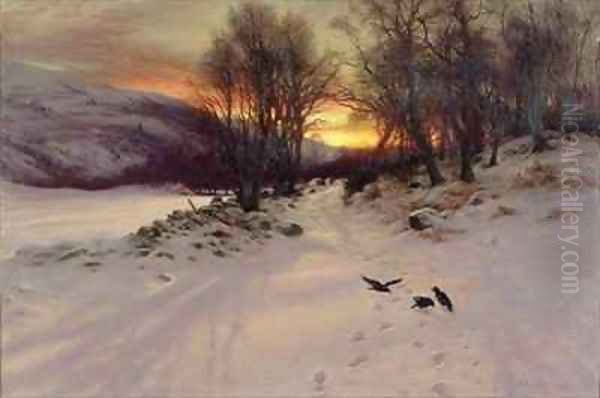
Farquharson was deeply committed to capturing the truth of nature, which led him to embrace and adapt the practice of en plein air (painting outdoors) long before it became commonplace, especially for large-scale works. To combat the notoriously harsh Scottish weather while painting his beloved winter scenes, he devised ingenious mobile studios. He constructed a small, heated hut on wheels, complete with a large glass window, which could be moved around the Finzean estate to the desired location. This allowed him to observe and paint the effects of snow and winter light directly from nature, in relative comfort, ensuring accuracy and immediacy.
Another testament to his dedication to realism was his use of a flock of artificial, or model, sheep. While he undoubtedly observed real sheep, having lifelike models allowed him to study poses and compositions meticulously within his studio or the mobile hut, especially when weather conditions or animal behaviour were uncooperative. This practice, unusual for the time, underscores his commitment to achieving the precise effects he desired in his finished canvases.
Expanding Horizons: Orientalism and Other Subjects
While best known for his Scottish snowscapes, Farquharson's artistic interests were not confined to his native land. Like many Victorian artists, he travelled, notably visiting Egypt. These travels inspired a series of Orientalist paintings, depicting North African scenes, figures, and architecture. Though fewer in number than his Scottish works, these paintings demonstrate his versatility and engagement with the popular 19th-century fascination with the 'Orient'. They showcase his skill in rendering different qualities of light, atmosphere, and cultural detail, contrasting sharply with the cool palette of his winter scenes. He also painted other Scottish landscapes, including autumnal scenes and depictions of Highland cattle.
Poetry in Paint: Evocative Titles
Farquharson often enhanced the evocative mood of his paintings by giving them poetic or literary titles. He frequently drew upon lines from famous poets, including the Scottish national bard Robert Burns (1759-1796), as well as English masters like John Milton (1608-1674), William Shakespeare (1564-1616), and Thomas Gray (1716-1771). Titles such as The Shortening Winter's Day is Near a Close (from Gray's "Elegy Written in a Country Churchyard") or Cauld Blaws the Wind Frae East to West (from Burns) added a layer of narrative or emotional resonance, inviting viewers to connect the visual scene with established literary sentiments. This practice aligned well with Victorian tastes, which often favoured art with narrative or moral dimensions.
Contemporaries, Context, and Critical Reception
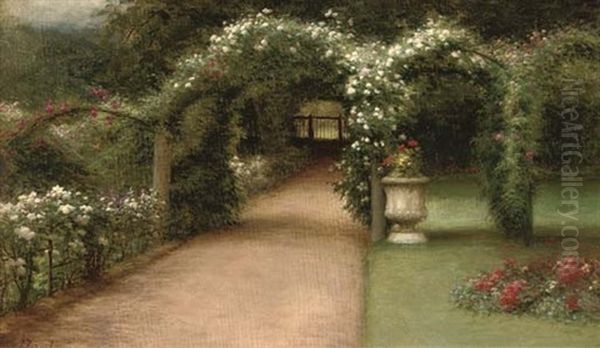
Farquharson operated within a thriving British art scene. His relationship with his early mentor, Peter Graham, remained significant. While direct competition isn't heavily documented, he would have been aware of other successful landscape painters of the era, such as Benjamin Williams Leader (1831-1923), known for his picturesque English landscapes. Within Scotland, the later 19th century saw the rise of the Glasgow Boys, including figures like James Guthrie (1859-1930) and George Henry (1858-1943), who were exploring more radical, French-influenced styles, often with bolder brushwork and flatter perspectives.
Farquharson's more traditional, albeit highly skilled, realism placed him somewhat apart from these avant-garde movements. His work was generally well-received by the public and established institutions like the Royal Academy and the Royal Scottish Academy, where he exhibited regularly. However, his adherence to realism did draw comment from proponents of modernism. The influential critic and artist Walter Sickert (1860-1942) reportedly remarked on Farquharson's style in relation to the modernist aesthetics championed by the Bloomsbury Group (including Roger Fry, Vanessa Bell, and Duncan Grant), suggesting Farquharson's traditionalism was perhaps ill-suited to the perceived progressive trajectory of art, at least from Sickert's perspective. This highlights the artistic debates of the period between established realism and emerging modernist trends.
Recognition, Lairdship, and Later Life
Farquharson achieved considerable success during his lifetime. He was elected an Associate of the Royal Academy (ARA) in 1900 and a full Royal Academician (RA) in 1915. He was also an elected member of the Royal Scottish Academy (RSA). His paintings were popular, widely exhibited, and reproduced, finding their way into many collections.
After inheriting the Lairdship of Finzean in 1891, he successfully managed the dual responsibilities of artist and landowner. He continued to paint prolifically well into his later years, remaining dedicated to his craft and his beloved Aberdeenshire landscapes. Joseph Farquharson passed away at his home, Finzean House, on April 15, 1935, at the venerable age of 89, leaving behind a substantial body of work and a distinct legacy in Scottish art.
Legacy: Collections and Market Presence
Today, Joseph Farquharson's paintings are held in numerous public and private collections. Major institutions housing his work include the Tate Britain in London, the National Gallery of Scotland, the Royal Scottish Academy collection, and various municipal galleries across the UK, including Aberdeen Art Gallery, Leeds Art Gallery, and National Museums Liverpool.
His work remains popular on the art market, particularly his signature snow scenes with sheep. Auction records reflect continued collector interest. For example:
A painting titled Sheep Grazing sold for £18,000 in April 2022.
A garden path by Joseph Farquharson (oil on canvas, 17.5 x 11.5 inches) sold for £5,000 at Halls auctioneers on April 23, 2022.
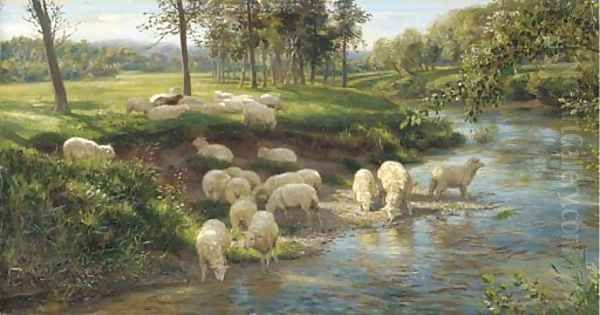
A wet walk home (oil on canvas) achieved £5,500 at Charterhouse auctioneers on January 5, 2023, exceeding its estimate of £1,400-£1,600.
Conversely, smaller or less typical works can fetch more modest sums, such as Through the Woods, estimated at £30-£50 in April 2022.
Not all works meet reserve prices; The Garden at Finzean, estimated at £6,000-£8,000, went unsold in a 2022 auction.
These records indicate a consistent market presence, with prime examples commanding significant prices, confirming his status as a sought-after Victorian artist.
Enduring Influence
Joseph Farquharson's primary influence lies in his mastery of a specific genre: the Scottish winter landscape. He set a high standard for capturing the effects of light on snow and rendering the atmosphere of the Highlands with both realism and poetic sensibility. His dedication to en plein air painting, facilitated by his innovative mobile studio, demonstrated a commitment to direct observation that resonated with naturalist principles. While perhaps not radically innovative in the manner of the Impressionists or later modernists, his technical skill, consistent vision, and the sheer appeal of his chosen subject matter secured his place in British art history. He remains one of the most recognisable and beloved painters of the Scottish landscape, whose works continue to evoke the beauty and atmosphere of his native land.
Conclusion
Joseph Farquharson, "The Painting Laird," occupies a respected position in the annals of Scottish art. Through his dedicated observation, technical proficiency, and deep connection to his Aberdeenshire home, he created a body of work that celebrates the unique beauty of the Scottish landscape, particularly under its winter mantle. His snowscapes, imbued with subtle light and populated by his iconic sheep, transcend mere topographical records, offering evocative glimpses into the atmosphere and mood of the natural world. His blend of realism, atmospheric sensitivity, and occasional poetic allusion continues to captivate audiences, ensuring his enduring legacy as a master of the snowscape.